Project Report: City Hospital Care for Aboriginal Patients' Health
VerifiedAdded on 2023/04/10
|19
|3841
|243
Report
AI Summary
This report analyzes the City Hospital Care project focusing on the healthcare of Aboriginal people. It begins with an introduction to the health status of Aboriginal and Torres Strait Islander people in Australia, including demographic data, life stages, and leading causes of mortality and hospital admissions. The report then delves into the concept of patient journey mapping, outlining the different phases of the patient experience and the factors impacting it. It describes findings from the patient journey mapping activities, including a narrative account of patient experiences and the importance of social and emotional wellbeing, family and community commitments, and cultural considerations. The role of Registered Nurses in meeting the healthcare needs of Aboriginal and Torres Strait Islander people is examined, emphasizing the importance of cultural capability and clinical yarning. The analysis of social and clinical yarns within interviews informs the role of a culturally capable Registered Nurse. The report concludes with a summary of key findings and recommendations for improving Aboriginal patient journeys. The report uses the Managing Two Worlds Together Project to understand the experiences of an Aboriginal person and their patient journey in receiving care. This report is based on interviews with healthcare experts.
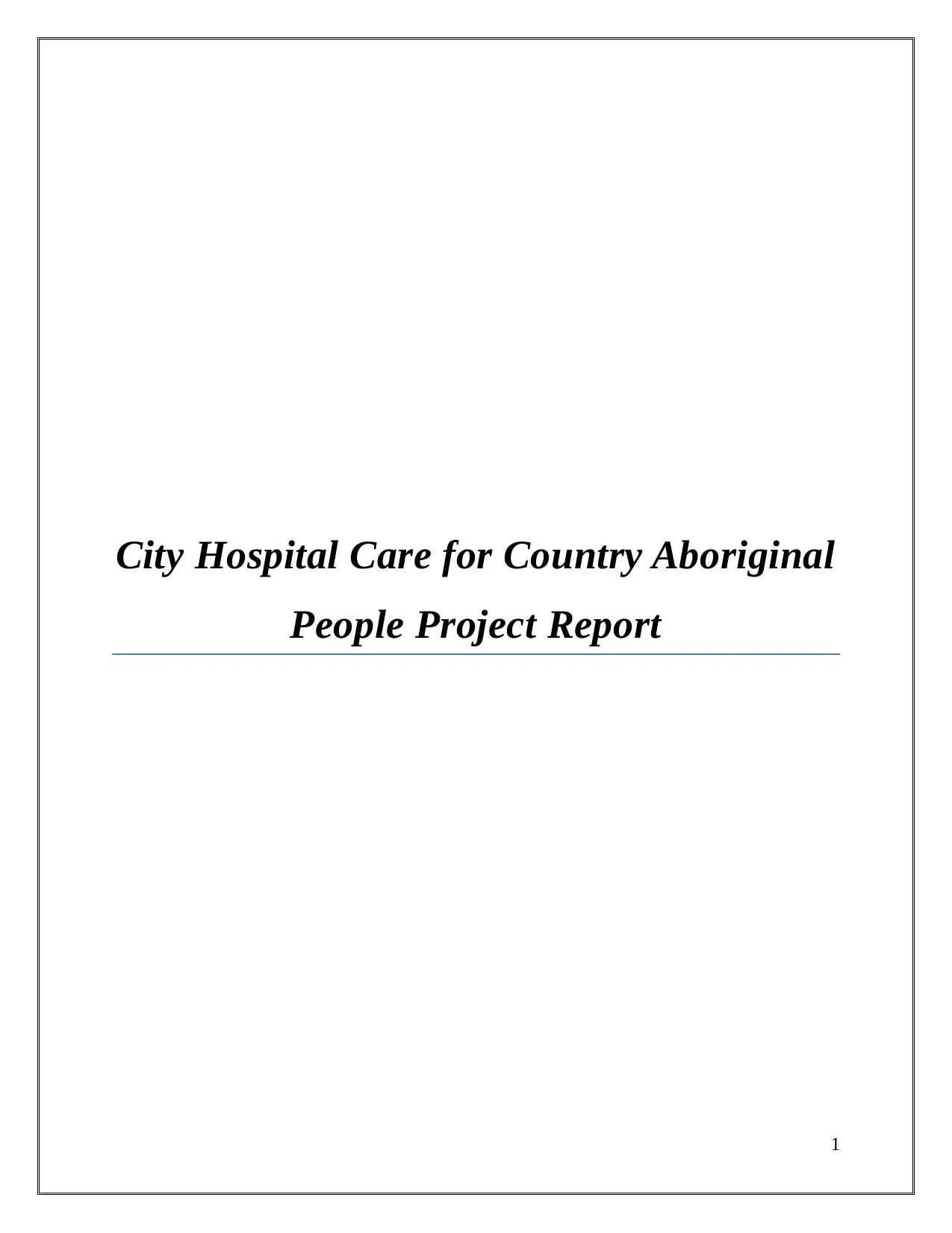
City Hospital Care for Country Aboriginal
People Project Report
1
People Project Report
1
Paraphrase This Document
Need a fresh take? Get an instant paraphrase of this document with our AI Paraphraser
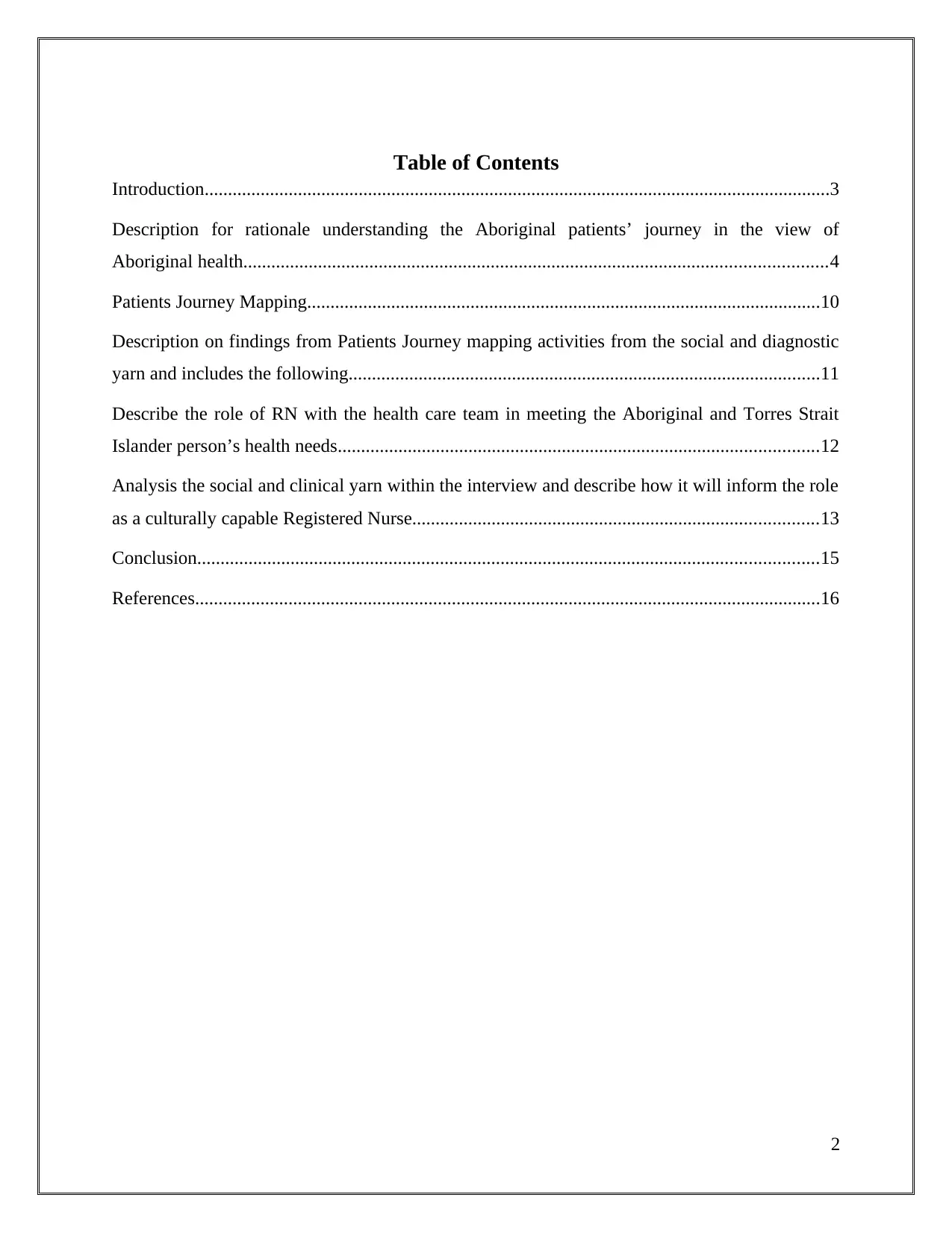
Table of Contents
Introduction......................................................................................................................................3
Description for rationale understanding the Aboriginal patients’ journey in the view of
Aboriginal health.............................................................................................................................4
Patients Journey Mapping..............................................................................................................10
Description on findings from Patients Journey mapping activities from the social and diagnostic
yarn and includes the following.....................................................................................................11
Describe the role of RN with the health care team in meeting the Aboriginal and Torres Strait
Islander person’s health needs.......................................................................................................12
Analysis the social and clinical yarn within the interview and describe how it will inform the role
as a culturally capable Registered Nurse.......................................................................................13
Conclusion.....................................................................................................................................15
References......................................................................................................................................16
2
Introduction......................................................................................................................................3
Description for rationale understanding the Aboriginal patients’ journey in the view of
Aboriginal health.............................................................................................................................4
Patients Journey Mapping..............................................................................................................10
Description on findings from Patients Journey mapping activities from the social and diagnostic
yarn and includes the following.....................................................................................................11
Describe the role of RN with the health care team in meeting the Aboriginal and Torres Strait
Islander person’s health needs.......................................................................................................12
Analysis the social and clinical yarn within the interview and describe how it will inform the role
as a culturally capable Registered Nurse.......................................................................................13
Conclusion.....................................................................................................................................15
References......................................................................................................................................16
2
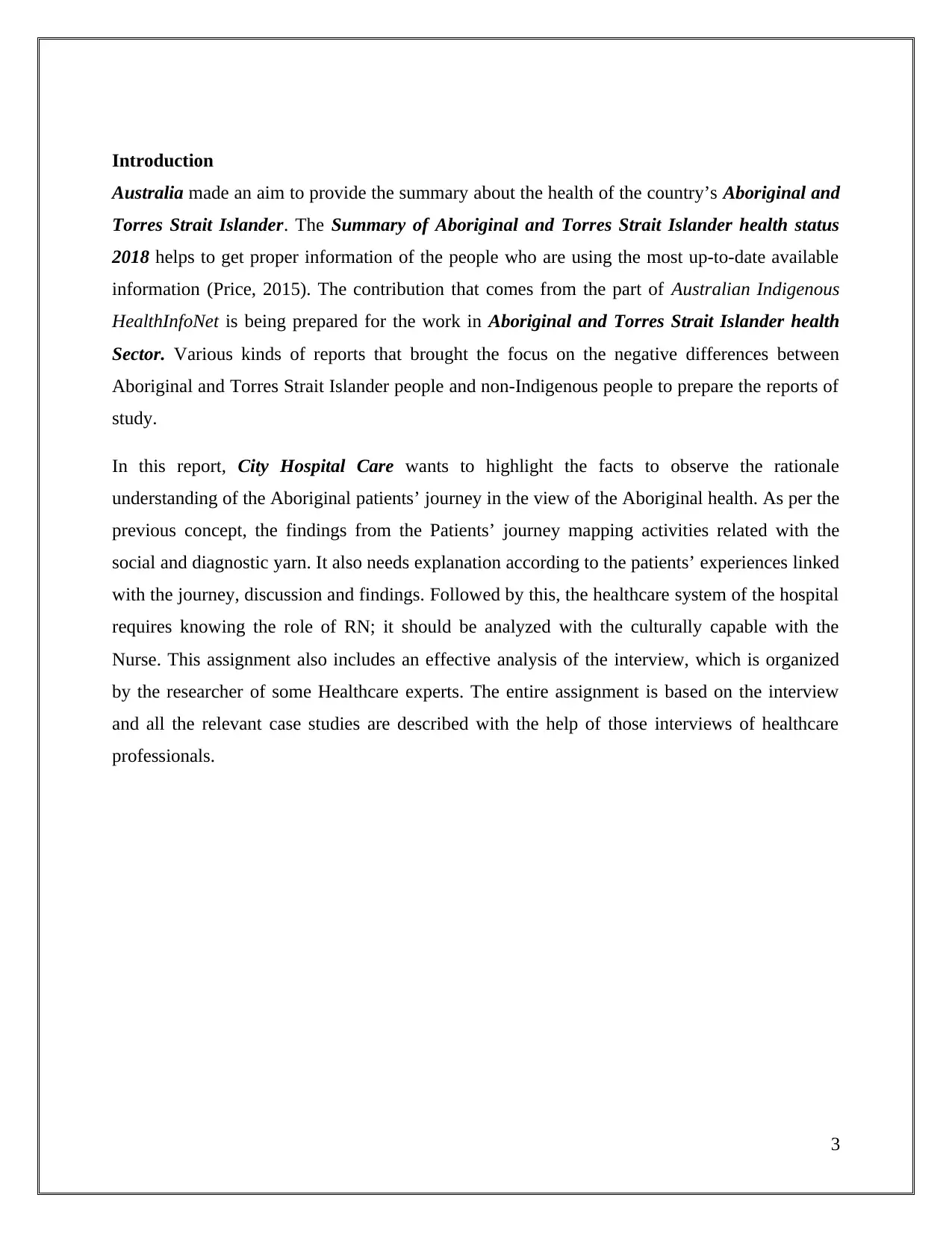
Introduction
Australia made an aim to provide the summary about the health of the country’s Aboriginal and
Torres Strait Islander. The Summary of Aboriginal and Torres Strait Islander health status
2018 helps to get proper information of the people who are using the most up-to-date available
information (Price, 2015). The contribution that comes from the part of Australian Indigenous
HealthInfoNet is being prepared for the work in Aboriginal and Torres Strait Islander health
Sector. Various kinds of reports that brought the focus on the negative differences between
Aboriginal and Torres Strait Islander people and non-Indigenous people to prepare the reports of
study.
In this report, City Hospital Care wants to highlight the facts to observe the rationale
understanding of the Aboriginal patients’ journey in the view of the Aboriginal health. As per the
previous concept, the findings from the Patients’ journey mapping activities related with the
social and diagnostic yarn. It also needs explanation according to the patients’ experiences linked
with the journey, discussion and findings. Followed by this, the healthcare system of the hospital
requires knowing the role of RN; it should be analyzed with the culturally capable with the
Nurse. This assignment also includes an effective analysis of the interview, which is organized
by the researcher of some Healthcare experts. The entire assignment is based on the interview
and all the relevant case studies are described with the help of those interviews of healthcare
professionals.
3
Australia made an aim to provide the summary about the health of the country’s Aboriginal and
Torres Strait Islander. The Summary of Aboriginal and Torres Strait Islander health status
2018 helps to get proper information of the people who are using the most up-to-date available
information (Price, 2015). The contribution that comes from the part of Australian Indigenous
HealthInfoNet is being prepared for the work in Aboriginal and Torres Strait Islander health
Sector. Various kinds of reports that brought the focus on the negative differences between
Aboriginal and Torres Strait Islander people and non-Indigenous people to prepare the reports of
study.
In this report, City Hospital Care wants to highlight the facts to observe the rationale
understanding of the Aboriginal patients’ journey in the view of the Aboriginal health. As per the
previous concept, the findings from the Patients’ journey mapping activities related with the
social and diagnostic yarn. It also needs explanation according to the patients’ experiences linked
with the journey, discussion and findings. Followed by this, the healthcare system of the hospital
requires knowing the role of RN; it should be analyzed with the culturally capable with the
Nurse. This assignment also includes an effective analysis of the interview, which is organized
by the researcher of some Healthcare experts. The entire assignment is based on the interview
and all the relevant case studies are described with the help of those interviews of healthcare
professionals.
3
⊘ This is a preview!⊘
Do you want full access?
Subscribe today to unlock all pages.

Trusted by 1+ million students worldwide
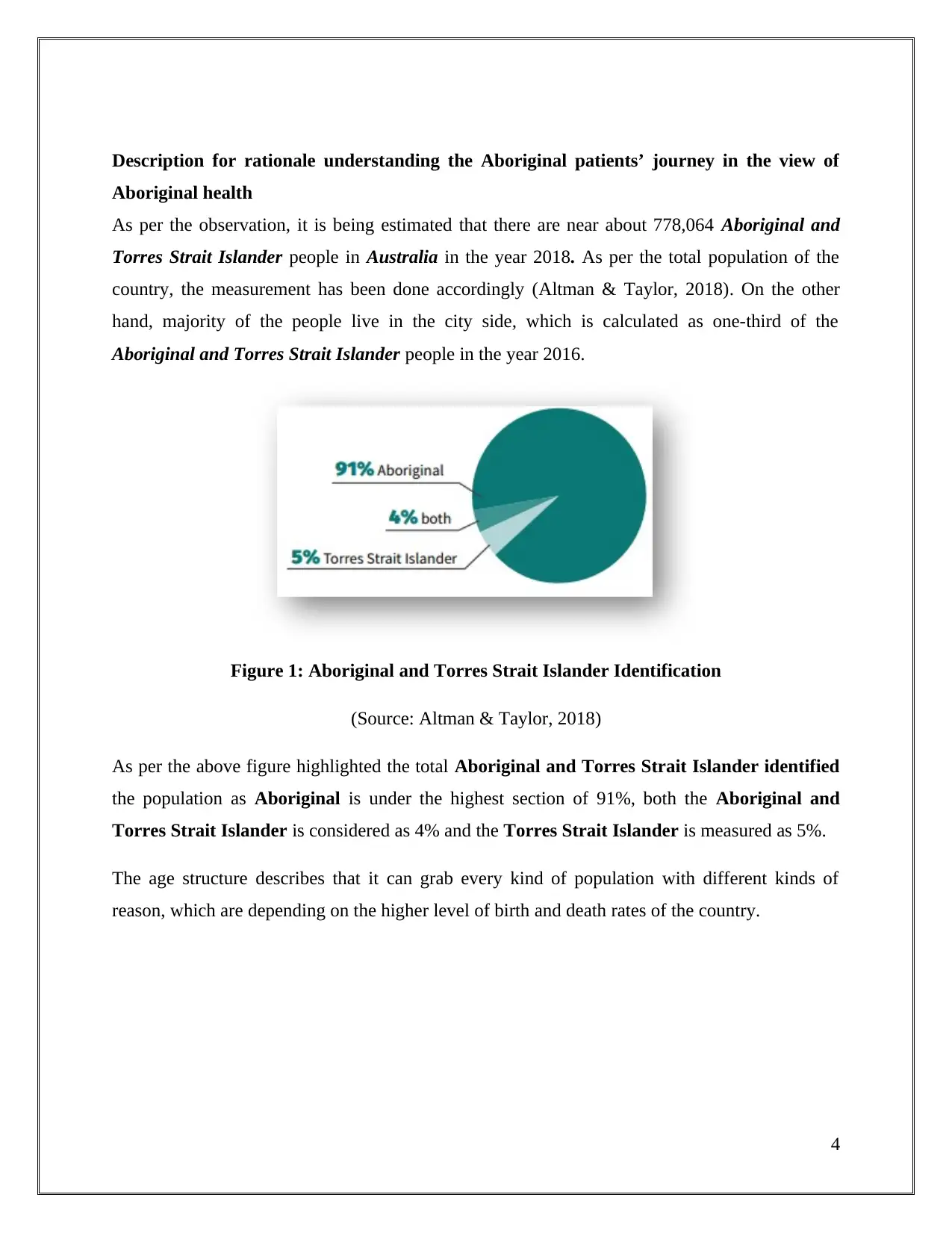
Description for rationale understanding the Aboriginal patients’ journey in the view of
Aboriginal health
As per the observation, it is being estimated that there are near about 778,064 Aboriginal and
Torres Strait Islander people in Australia in the year 2018. As per the total population of the
country, the measurement has been done accordingly (Altman & Taylor, 2018). On the other
hand, majority of the people live in the city side, which is calculated as one-third of the
Aboriginal and Torres Strait Islander people in the year 2016.
Figure 1: Aboriginal and Torres Strait Islander Identification
(Source: Altman & Taylor, 2018)
As per the above figure highlighted the total Aboriginal and Torres Strait Islander identified
the population as Aboriginal is under the highest section of 91%, both the Aboriginal and
Torres Strait Islander is considered as 4% and the Torres Strait Islander is measured as 5%.
The age structure describes that it can grab every kind of population with different kinds of
reason, which are depending on the higher level of birth and death rates of the country.
4
Aboriginal health
As per the observation, it is being estimated that there are near about 778,064 Aboriginal and
Torres Strait Islander people in Australia in the year 2018. As per the total population of the
country, the measurement has been done accordingly (Altman & Taylor, 2018). On the other
hand, majority of the people live in the city side, which is calculated as one-third of the
Aboriginal and Torres Strait Islander people in the year 2016.
Figure 1: Aboriginal and Torres Strait Islander Identification
(Source: Altman & Taylor, 2018)
As per the above figure highlighted the total Aboriginal and Torres Strait Islander identified
the population as Aboriginal is under the highest section of 91%, both the Aboriginal and
Torres Strait Islander is considered as 4% and the Torres Strait Islander is measured as 5%.
The age structure describes that it can grab every kind of population with different kinds of
reason, which are depending on the higher level of birth and death rates of the country.
4
Paraphrase This Document
Need a fresh take? Get an instant paraphrase of this document with our AI Paraphraser
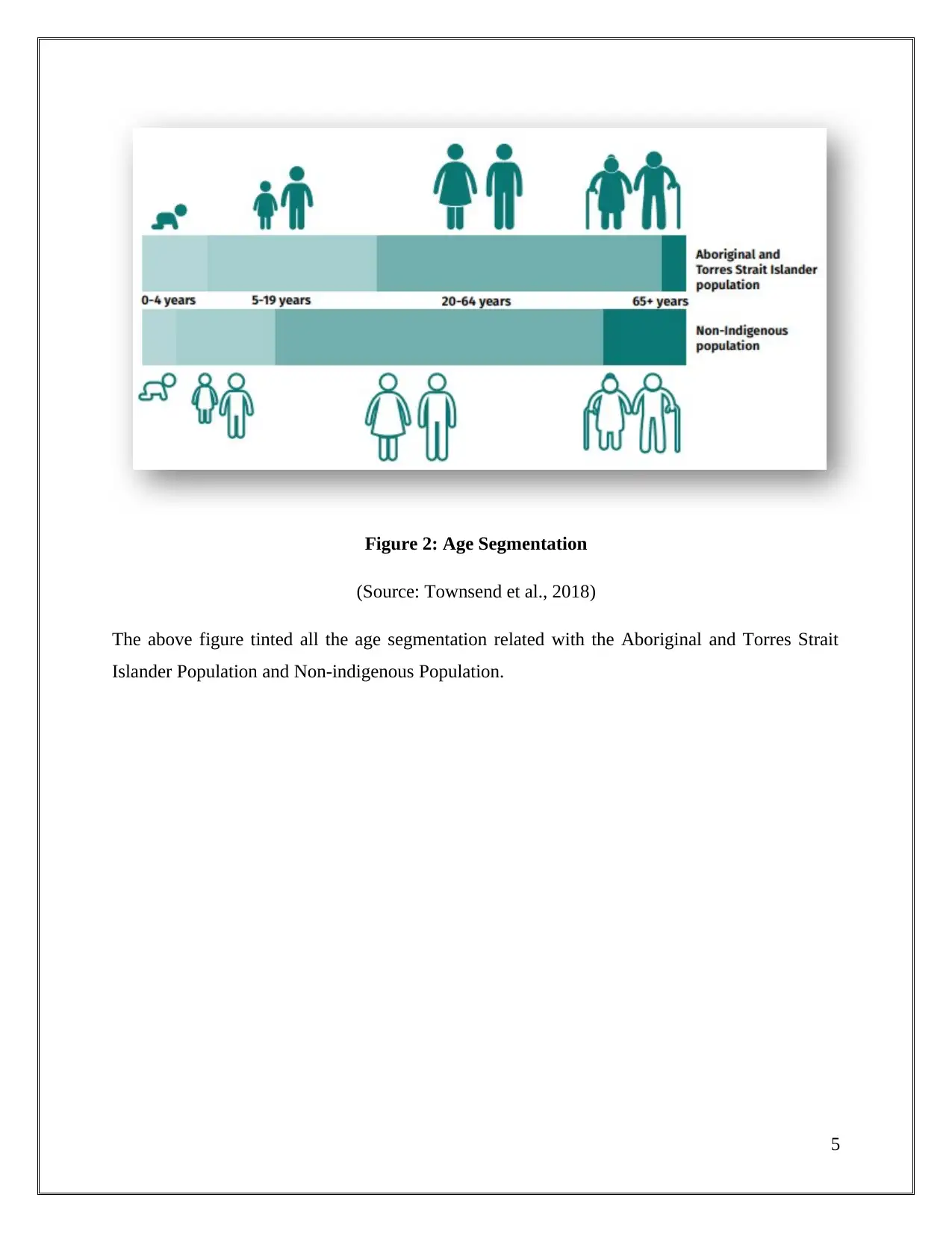
Figure 2: Age Segmentation
(Source: Townsend et al., 2018)
The above figure tinted all the age segmentation related with the Aboriginal and Torres Strait
Islander Population and Non-indigenous Population.
5
(Source: Townsend et al., 2018)
The above figure tinted all the age segmentation related with the Aboriginal and Torres Strait
Islander Population and Non-indigenous Population.
5
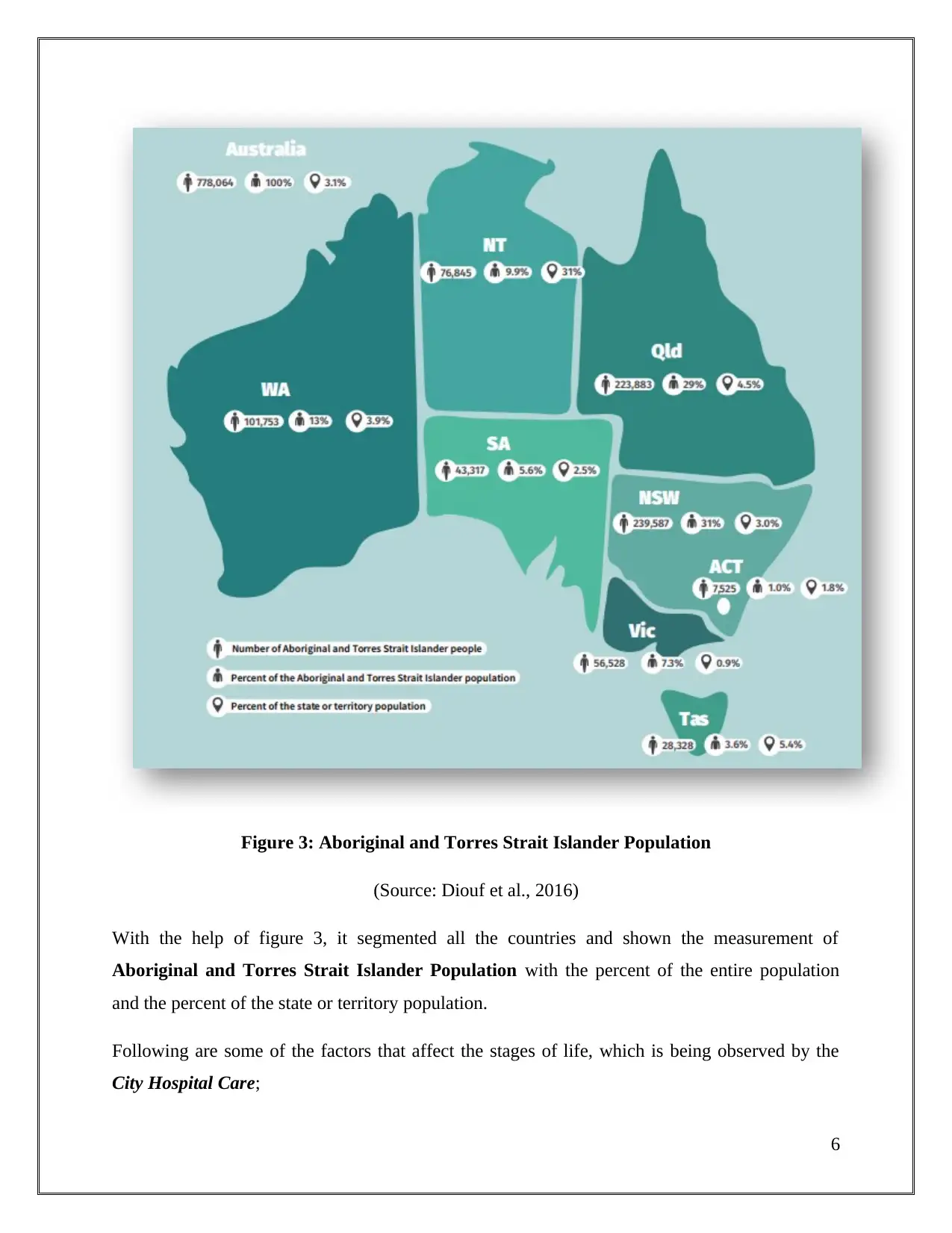
Figure 3: Aboriginal and Torres Strait Islander Population
(Source: Diouf et al., 2016)
With the help of figure 3, it segmented all the countries and shown the measurement of
Aboriginal and Torres Strait Islander Population with the percent of the entire population
and the percent of the state or territory population.
Following are some of the factors that affect the stages of life, which is being observed by the
City Hospital Care;
6
(Source: Diouf et al., 2016)
With the help of figure 3, it segmented all the countries and shown the measurement of
Aboriginal and Torres Strait Islander Population with the percent of the entire population
and the percent of the state or territory population.
Following are some of the factors that affect the stages of life, which is being observed by the
City Hospital Care;
6
⊘ This is a preview!⊘
Do you want full access?
Subscribe today to unlock all pages.

Trusted by 1+ million students worldwide
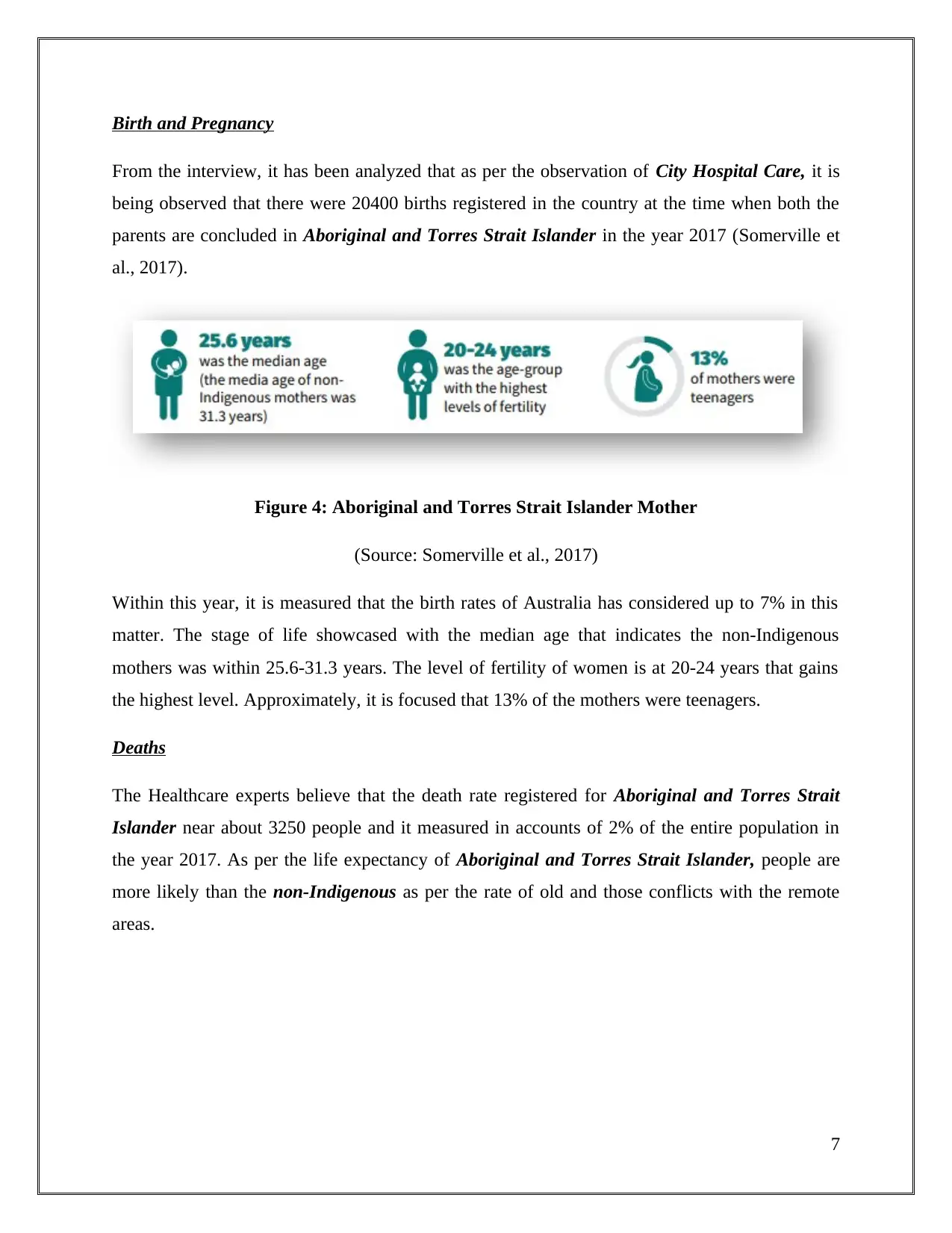
Birth and Pregnancy
From the interview, it has been analyzed that as per the observation of City Hospital Care, it is
being observed that there were 20400 births registered in the country at the time when both the
parents are concluded in Aboriginal and Torres Strait Islander in the year 2017 (Somerville et
al., 2017).
Figure 4: Aboriginal and Torres Strait Islander Mother
(Source: Somerville et al., 2017)
Within this year, it is measured that the birth rates of Australia has considered up to 7% in this
matter. The stage of life showcased with the median age that indicates the non-Indigenous
mothers was within 25.6-31.3 years. The level of fertility of women is at 20-24 years that gains
the highest level. Approximately, it is focused that 13% of the mothers were teenagers.
Deaths
The Healthcare experts believe that the death rate registered for Aboriginal and Torres Strait
Islander near about 3250 people and it measured in accounts of 2% of the entire population in
the year 2017. As per the life expectancy of Aboriginal and Torres Strait Islander, people are
more likely than the non-Indigenous as per the rate of old and those conflicts with the remote
areas.
7
From the interview, it has been analyzed that as per the observation of City Hospital Care, it is
being observed that there were 20400 births registered in the country at the time when both the
parents are concluded in Aboriginal and Torres Strait Islander in the year 2017 (Somerville et
al., 2017).
Figure 4: Aboriginal and Torres Strait Islander Mother
(Source: Somerville et al., 2017)
Within this year, it is measured that the birth rates of Australia has considered up to 7% in this
matter. The stage of life showcased with the median age that indicates the non-Indigenous
mothers was within 25.6-31.3 years. The level of fertility of women is at 20-24 years that gains
the highest level. Approximately, it is focused that 13% of the mothers were teenagers.
Deaths
The Healthcare experts believe that the death rate registered for Aboriginal and Torres Strait
Islander near about 3250 people and it measured in accounts of 2% of the entire population in
the year 2017. As per the life expectancy of Aboriginal and Torres Strait Islander, people are
more likely than the non-Indigenous as per the rate of old and those conflicts with the remote
areas.
7
Paraphrase This Document
Need a fresh take? Get an instant paraphrase of this document with our AI Paraphraser
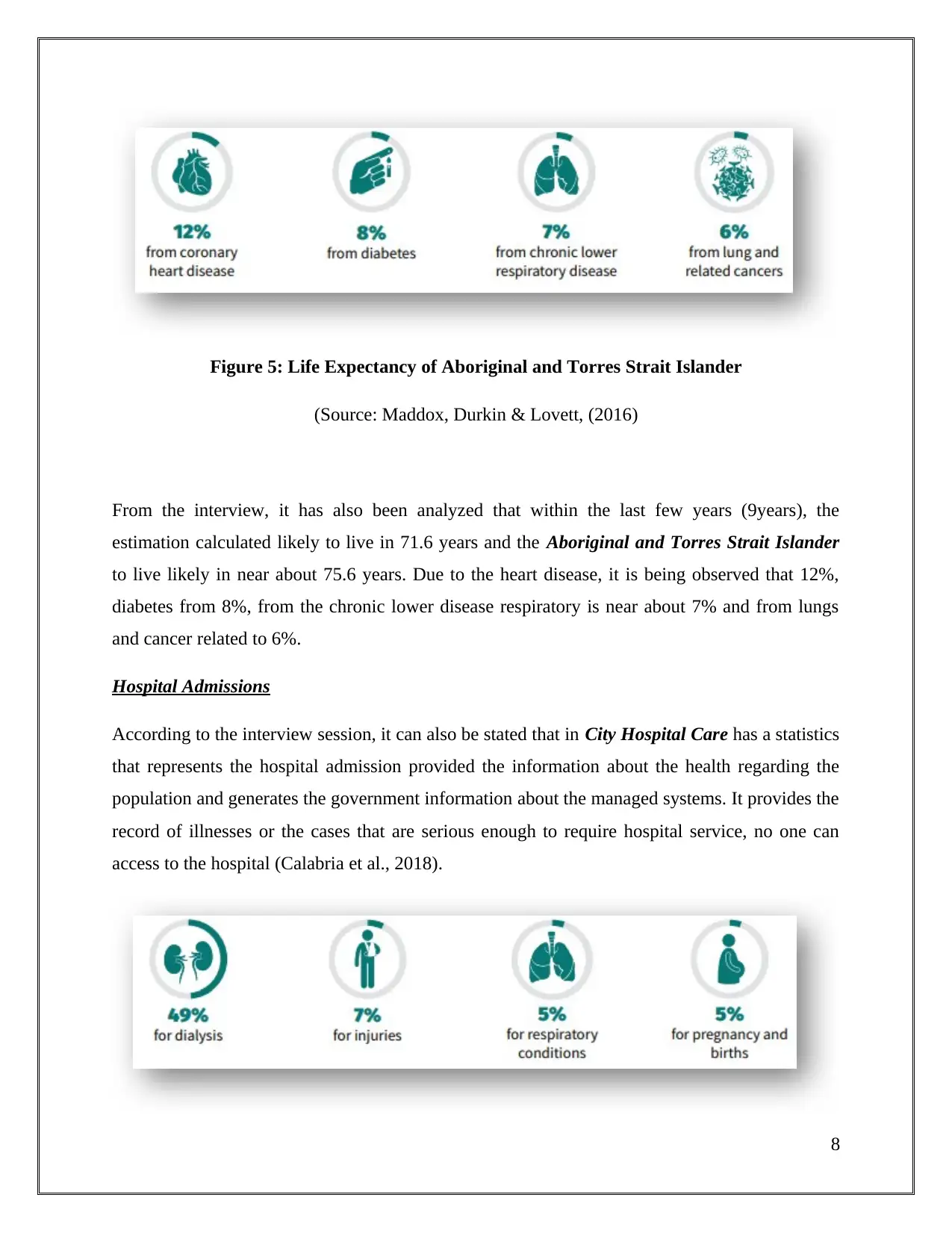
Figure 5: Life Expectancy of Aboriginal and Torres Strait Islander
(Source: Maddox, Durkin & Lovett, (2016)
From the interview, it has also been analyzed that within the last few years (9years), the
estimation calculated likely to live in 71.6 years and the Aboriginal and Torres Strait Islander
to live likely in near about 75.6 years. Due to the heart disease, it is being observed that 12%,
diabetes from 8%, from the chronic lower disease respiratory is near about 7% and from lungs
and cancer related to 6%.
Hospital Admissions
According to the interview session, it can also be stated that in City Hospital Care has a statistics
that represents the hospital admission provided the information about the health regarding the
population and generates the government information about the managed systems. It provides the
record of illnesses or the cases that are serious enough to require hospital service, no one can
access to the hospital (Calabria et al., 2018).
8
(Source: Maddox, Durkin & Lovett, (2016)
From the interview, it has also been analyzed that within the last few years (9years), the
estimation calculated likely to live in 71.6 years and the Aboriginal and Torres Strait Islander
to live likely in near about 75.6 years. Due to the heart disease, it is being observed that 12%,
diabetes from 8%, from the chronic lower disease respiratory is near about 7% and from lungs
and cancer related to 6%.
Hospital Admissions
According to the interview session, it can also be stated that in City Hospital Care has a statistics
that represents the hospital admission provided the information about the health regarding the
population and generates the government information about the managed systems. It provides the
record of illnesses or the cases that are serious enough to require hospital service, no one can
access to the hospital (Calabria et al., 2018).
8
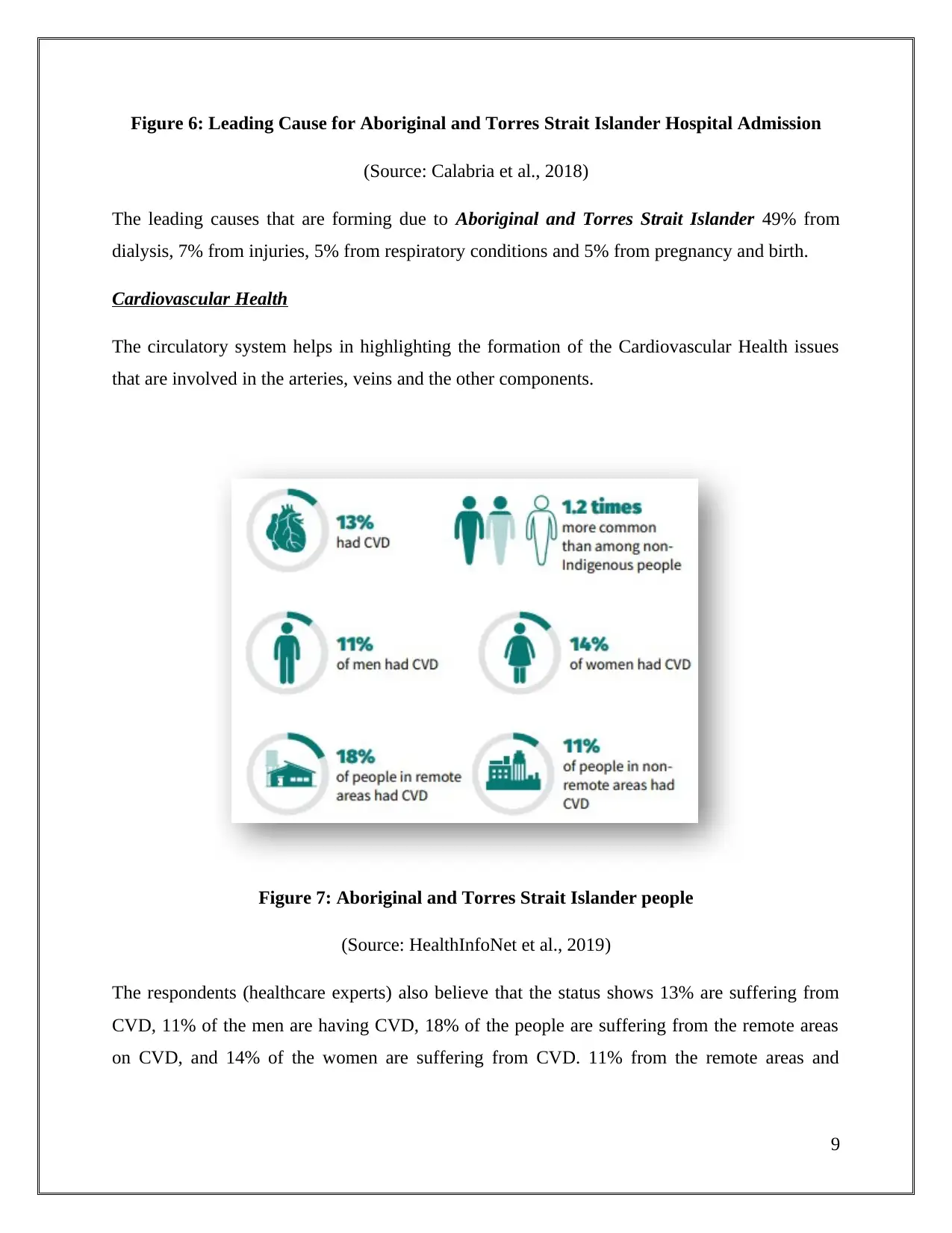
Figure 6: Leading Cause for Aboriginal and Torres Strait Islander Hospital Admission
(Source: Calabria et al., 2018)
The leading causes that are forming due to Aboriginal and Torres Strait Islander 49% from
dialysis, 7% from injuries, 5% from respiratory conditions and 5% from pregnancy and birth.
Cardiovascular Health
The circulatory system helps in highlighting the formation of the Cardiovascular Health issues
that are involved in the arteries, veins and the other components.
Figure 7: Aboriginal and Torres Strait Islander people
(Source: HealthInfoNet et al., 2019)
The respondents (healthcare experts) also believe that the status shows 13% are suffering from
CVD, 11% of the men are having CVD, 18% of the people are suffering from the remote areas
on CVD, and 14% of the women are suffering from CVD. 11% from the remote areas and
9
(Source: Calabria et al., 2018)
The leading causes that are forming due to Aboriginal and Torres Strait Islander 49% from
dialysis, 7% from injuries, 5% from respiratory conditions and 5% from pregnancy and birth.
Cardiovascular Health
The circulatory system helps in highlighting the formation of the Cardiovascular Health issues
that are involved in the arteries, veins and the other components.
Figure 7: Aboriginal and Torres Strait Islander people
(Source: HealthInfoNet et al., 2019)
The respondents (healthcare experts) also believe that the status shows 13% are suffering from
CVD, 11% of the men are having CVD, 18% of the people are suffering from the remote areas
on CVD, and 14% of the women are suffering from CVD. 11% from the remote areas and
9
⊘ This is a preview!⊘
Do you want full access?
Subscribe today to unlock all pages.

Trusted by 1+ million students worldwide
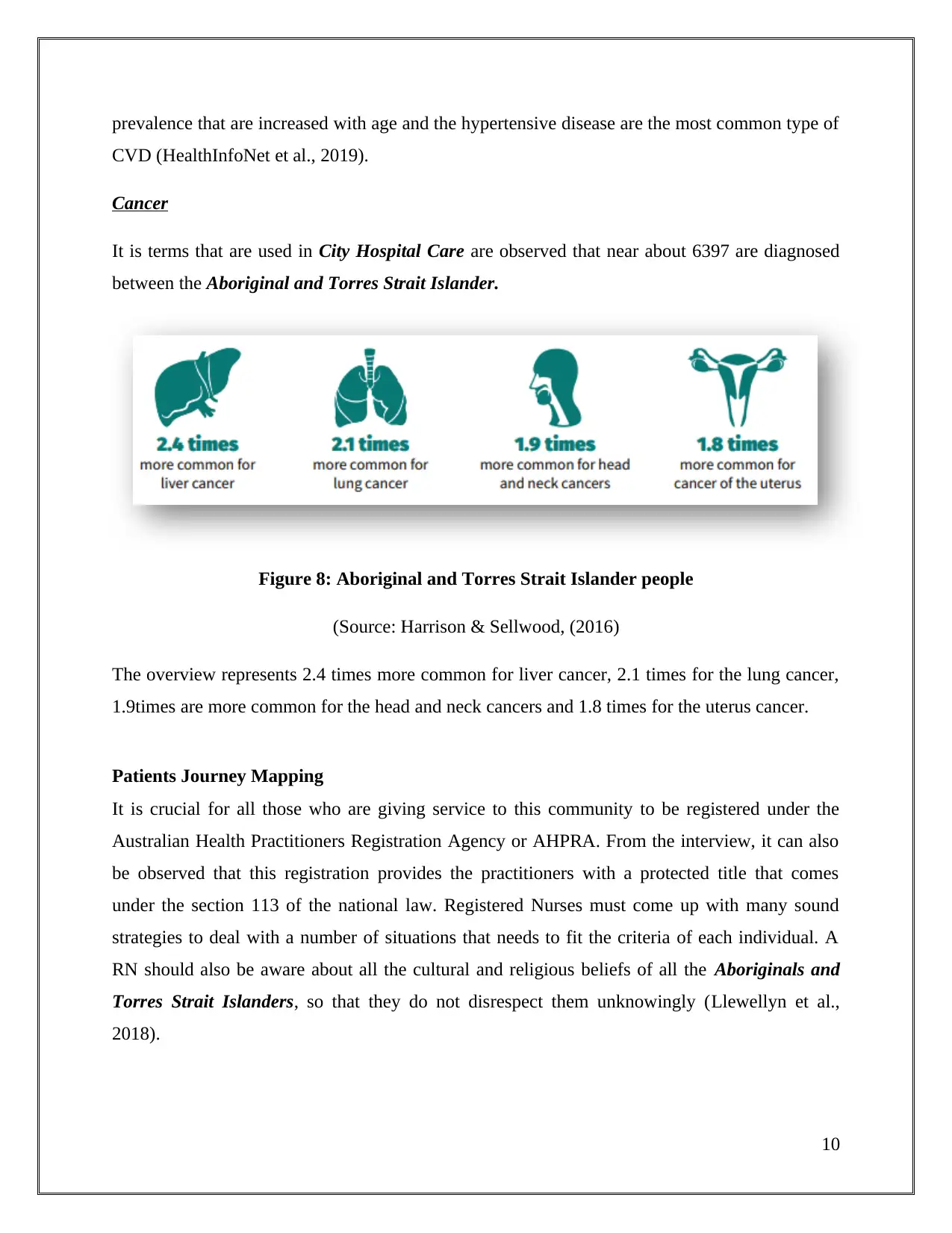
prevalence that are increased with age and the hypertensive disease are the most common type of
CVD (HealthInfoNet et al., 2019).
Cancer
It is terms that are used in City Hospital Care are observed that near about 6397 are diagnosed
between the Aboriginal and Torres Strait Islander.
Figure 8: Aboriginal and Torres Strait Islander people
(Source: Harrison & Sellwood, (2016)
The overview represents 2.4 times more common for liver cancer, 2.1 times for the lung cancer,
1.9times are more common for the head and neck cancers and 1.8 times for the uterus cancer.
Patients Journey Mapping
It is crucial for all those who are giving service to this community to be registered under the
Australian Health Practitioners Registration Agency or AHPRA. From the interview, it can also
be observed that this registration provides the practitioners with a protected title that comes
under the section 113 of the national law. Registered Nurses must come up with many sound
strategies to deal with a number of situations that needs to fit the criteria of each individual. A
RN should also be aware about all the cultural and religious beliefs of all the Aboriginals and
Torres Strait Islanders, so that they do not disrespect them unknowingly (Llewellyn et al.,
2018).
10
CVD (HealthInfoNet et al., 2019).
Cancer
It is terms that are used in City Hospital Care are observed that near about 6397 are diagnosed
between the Aboriginal and Torres Strait Islander.
Figure 8: Aboriginal and Torres Strait Islander people
(Source: Harrison & Sellwood, (2016)
The overview represents 2.4 times more common for liver cancer, 2.1 times for the lung cancer,
1.9times are more common for the head and neck cancers and 1.8 times for the uterus cancer.
Patients Journey Mapping
It is crucial for all those who are giving service to this community to be registered under the
Australian Health Practitioners Registration Agency or AHPRA. From the interview, it can also
be observed that this registration provides the practitioners with a protected title that comes
under the section 113 of the national law. Registered Nurses must come up with many sound
strategies to deal with a number of situations that needs to fit the criteria of each individual. A
RN should also be aware about all the cultural and religious beliefs of all the Aboriginals and
Torres Strait Islanders, so that they do not disrespect them unknowingly (Llewellyn et al.,
2018).
10
Paraphrase This Document
Need a fresh take? Get an instant paraphrase of this document with our AI Paraphraser
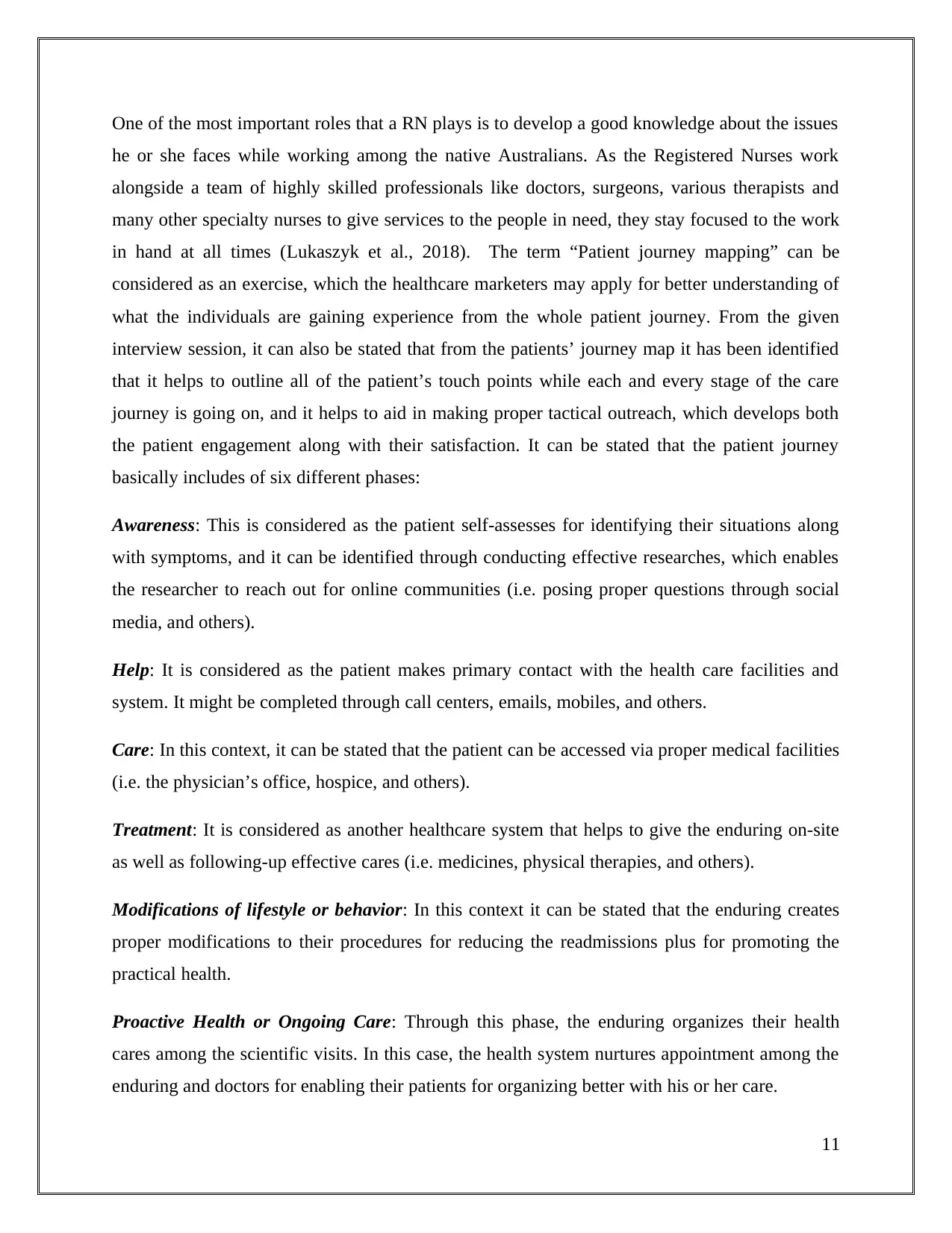
One of the most important roles that a RN plays is to develop a good knowledge about the issues
he or she faces while working among the native Australians. As the Registered Nurses work
alongside a team of highly skilled professionals like doctors, surgeons, various therapists and
many other specialty nurses to give services to the people in need, they stay focused to the work
in hand at all times (Lukaszyk et al., 2018). The term “Patient journey mapping” can be
considered as an exercise, which the healthcare marketers may apply for better understanding of
what the individuals are gaining experience from the whole patient journey. From the given
interview session, it can also be stated that from the patients’ journey map it has been identified
that it helps to outline all of the patient’s touch points while each and every stage of the care
journey is going on, and it helps to aid in making proper tactical outreach, which develops both
the patient engagement along with their satisfaction. It can be stated that the patient journey
basically includes of six different phases:
Awareness: This is considered as the patient self-assesses for identifying their situations along
with symptoms, and it can be identified through conducting effective researches, which enables
the researcher to reach out for online communities (i.e. posing proper questions through social
media, and others).
Help: It is considered as the patient makes primary contact with the health care facilities and
system. It might be completed through call centers, emails, mobiles, and others.
Care: In this context, it can be stated that the patient can be accessed via proper medical facilities
(i.e. the physician’s office, hospice, and others).
Treatment: It is considered as another healthcare system that helps to give the enduring on-site
as well as following-up effective cares (i.e. medicines, physical therapies, and others).
Modifications of lifestyle or behavior: In this context it can be stated that the enduring creates
proper modifications to their procedures for reducing the readmissions plus for promoting the
practical health.
Proactive Health or Ongoing Care: Through this phase, the enduring organizes their health
cares among the scientific visits. In this case, the health system nurtures appointment among the
enduring and doctors for enabling their patients for organizing better with his or her care.
11
he or she faces while working among the native Australians. As the Registered Nurses work
alongside a team of highly skilled professionals like doctors, surgeons, various therapists and
many other specialty nurses to give services to the people in need, they stay focused to the work
in hand at all times (Lukaszyk et al., 2018). The term “Patient journey mapping” can be
considered as an exercise, which the healthcare marketers may apply for better understanding of
what the individuals are gaining experience from the whole patient journey. From the given
interview session, it can also be stated that from the patients’ journey map it has been identified
that it helps to outline all of the patient’s touch points while each and every stage of the care
journey is going on, and it helps to aid in making proper tactical outreach, which develops both
the patient engagement along with their satisfaction. It can be stated that the patient journey
basically includes of six different phases:
Awareness: This is considered as the patient self-assesses for identifying their situations along
with symptoms, and it can be identified through conducting effective researches, which enables
the researcher to reach out for online communities (i.e. posing proper questions through social
media, and others).
Help: It is considered as the patient makes primary contact with the health care facilities and
system. It might be completed through call centers, emails, mobiles, and others.
Care: In this context, it can be stated that the patient can be accessed via proper medical facilities
(i.e. the physician’s office, hospice, and others).
Treatment: It is considered as another healthcare system that helps to give the enduring on-site
as well as following-up effective cares (i.e. medicines, physical therapies, and others).
Modifications of lifestyle or behavior: In this context it can be stated that the enduring creates
proper modifications to their procedures for reducing the readmissions plus for promoting the
practical health.
Proactive Health or Ongoing Care: Through this phase, the enduring organizes their health
cares among the scientific visits. In this case, the health system nurtures appointment among the
enduring and doctors for enabling their patients for organizing better with his or her care.
11
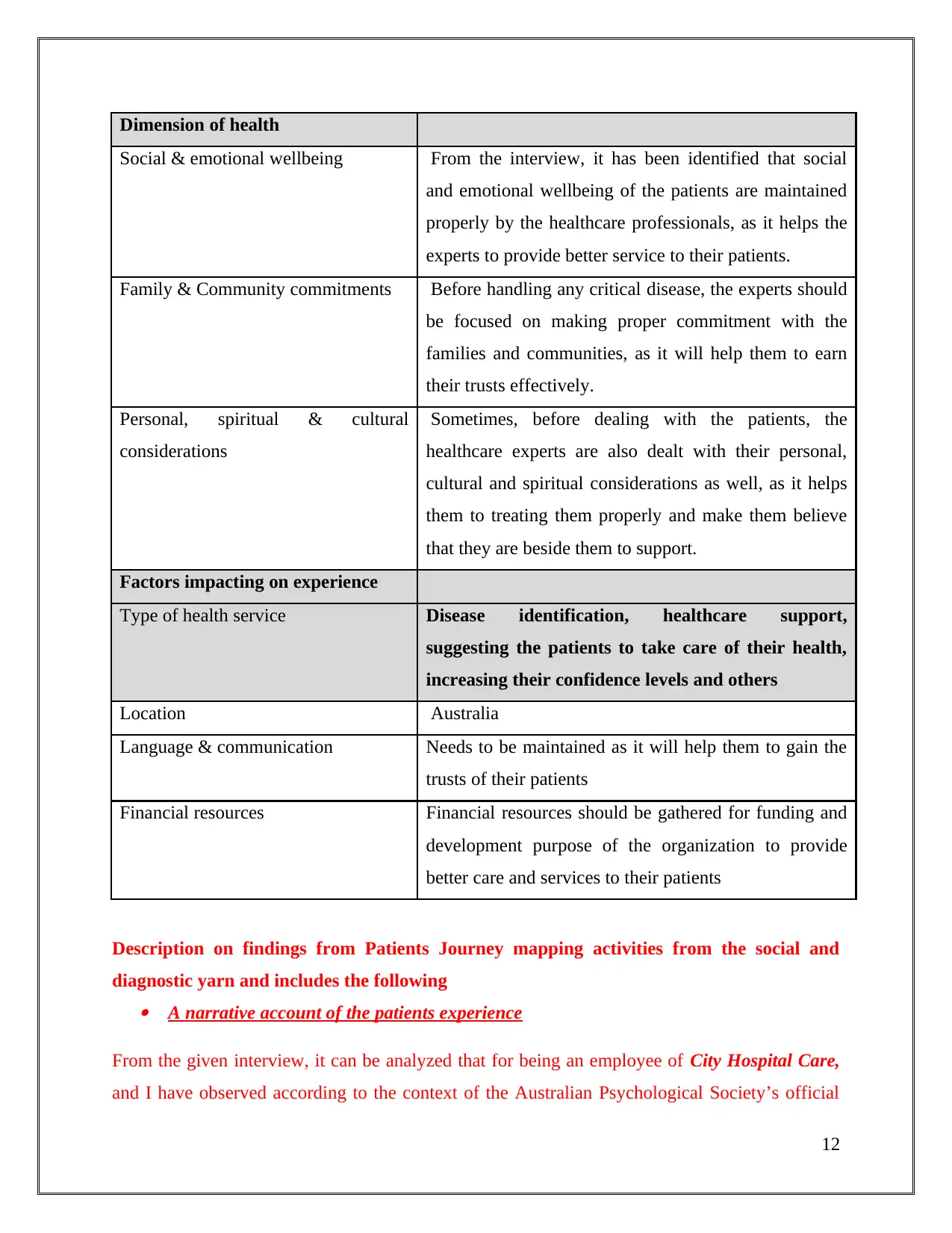
Dimension of health
Social & emotional wellbeing From the interview, it has been identified that social
and emotional wellbeing of the patients are maintained
properly by the healthcare professionals, as it helps the
experts to provide better service to their patients.
Family & Community commitments Before handling any critical disease, the experts should
be focused on making proper commitment with the
families and communities, as it will help them to earn
their trusts effectively.
Personal, spiritual & cultural
considerations
Sometimes, before dealing with the patients, the
healthcare experts are also dealt with their personal,
cultural and spiritual considerations as well, as it helps
them to treating them properly and make them believe
that they are beside them to support.
Factors impacting on experience
Type of health service Disease identification, healthcare support,
suggesting the patients to take care of their health,
increasing their confidence levels and others
Location Australia
Language & communication Needs to be maintained as it will help them to gain the
trusts of their patients
Financial resources Financial resources should be gathered for funding and
development purpose of the organization to provide
better care and services to their patients
Description on findings from Patients Journey mapping activities from the social and
diagnostic yarn and includes the following A narrative account of the patients experience
From the given interview, it can be analyzed that for being an employee of City Hospital Care,
and I have observed according to the context of the Australian Psychological Society’s official
12
Social & emotional wellbeing From the interview, it has been identified that social
and emotional wellbeing of the patients are maintained
properly by the healthcare professionals, as it helps the
experts to provide better service to their patients.
Family & Community commitments Before handling any critical disease, the experts should
be focused on making proper commitment with the
families and communities, as it will help them to earn
their trusts effectively.
Personal, spiritual & cultural
considerations
Sometimes, before dealing with the patients, the
healthcare experts are also dealt with their personal,
cultural and spiritual considerations as well, as it helps
them to treating them properly and make them believe
that they are beside them to support.
Factors impacting on experience
Type of health service Disease identification, healthcare support,
suggesting the patients to take care of their health,
increasing their confidence levels and others
Location Australia
Language & communication Needs to be maintained as it will help them to gain the
trusts of their patients
Financial resources Financial resources should be gathered for funding and
development purpose of the organization to provide
better care and services to their patients
Description on findings from Patients Journey mapping activities from the social and
diagnostic yarn and includes the following A narrative account of the patients experience
From the given interview, it can be analyzed that for being an employee of City Hospital Care,
and I have observed according to the context of the Australian Psychological Society’s official
12
⊘ This is a preview!⊘
Do you want full access?
Subscribe today to unlock all pages.

Trusted by 1+ million students worldwide
1 out of 19
Related Documents
Your All-in-One AI-Powered Toolkit for Academic Success.
+13062052269
info@desklib.com
Available 24*7 on WhatsApp / Email
![[object Object]](/_next/static/media/star-bottom.7253800d.svg)
Unlock your academic potential
Copyright © 2020–2025 A2Z Services. All Rights Reserved. Developed and managed by ZUCOL.




